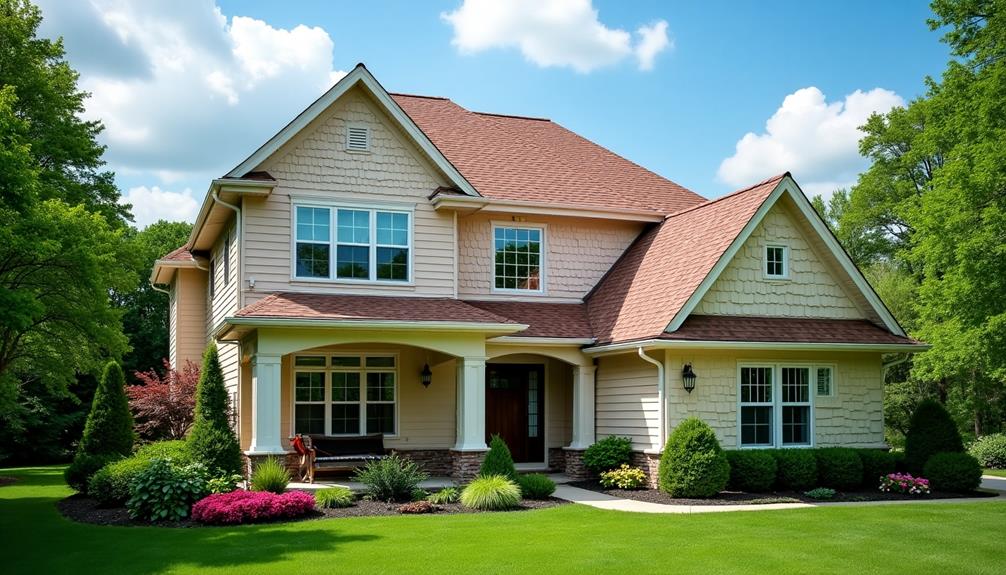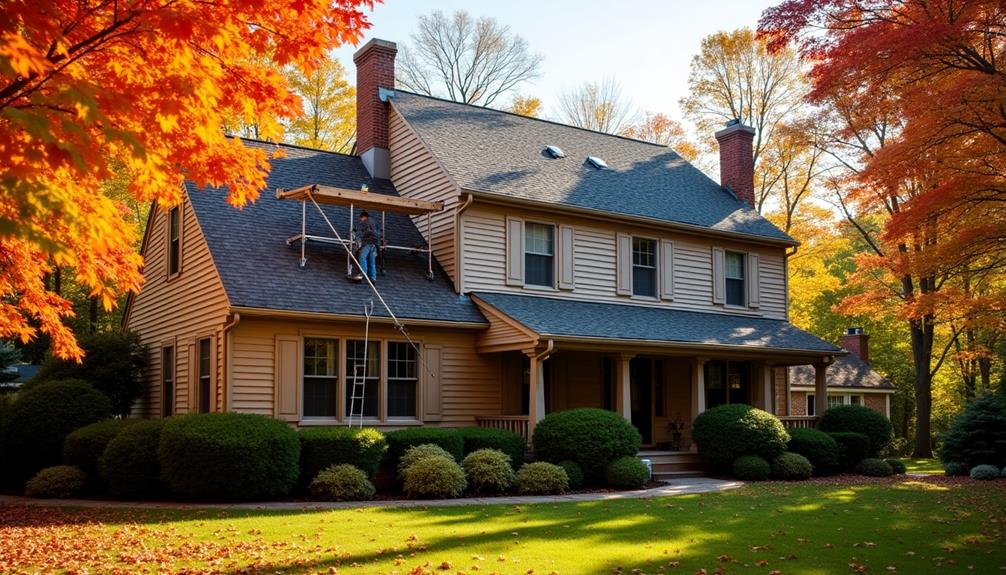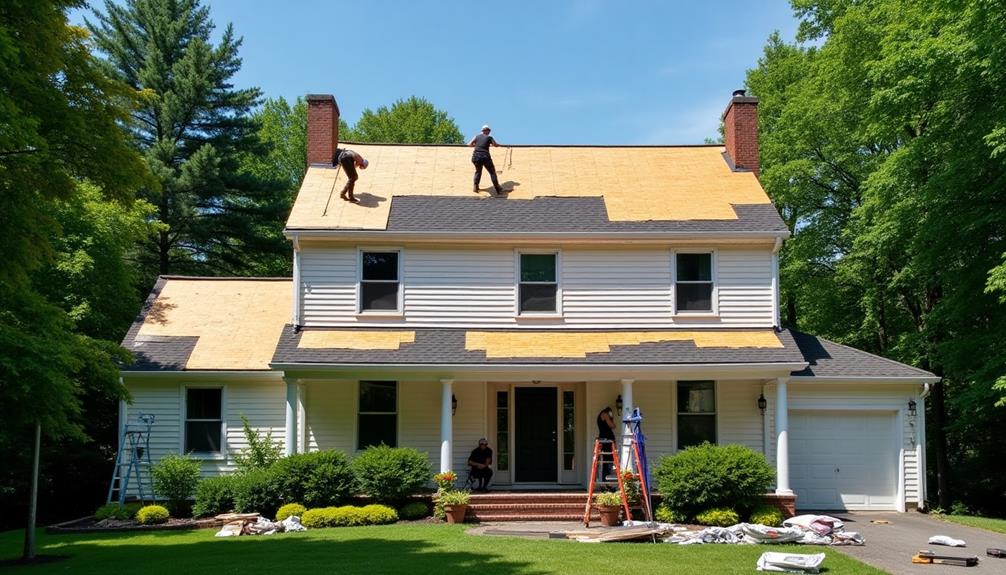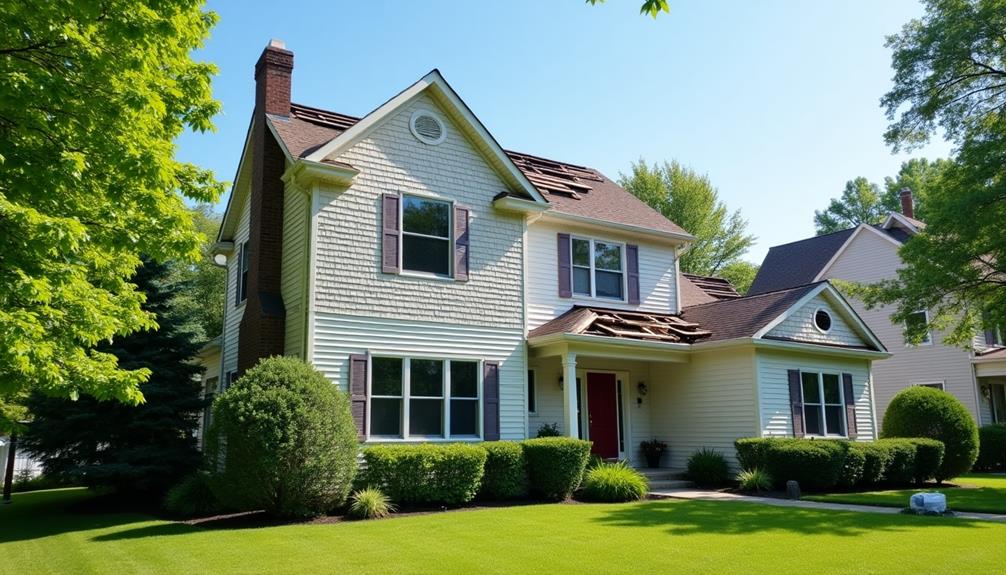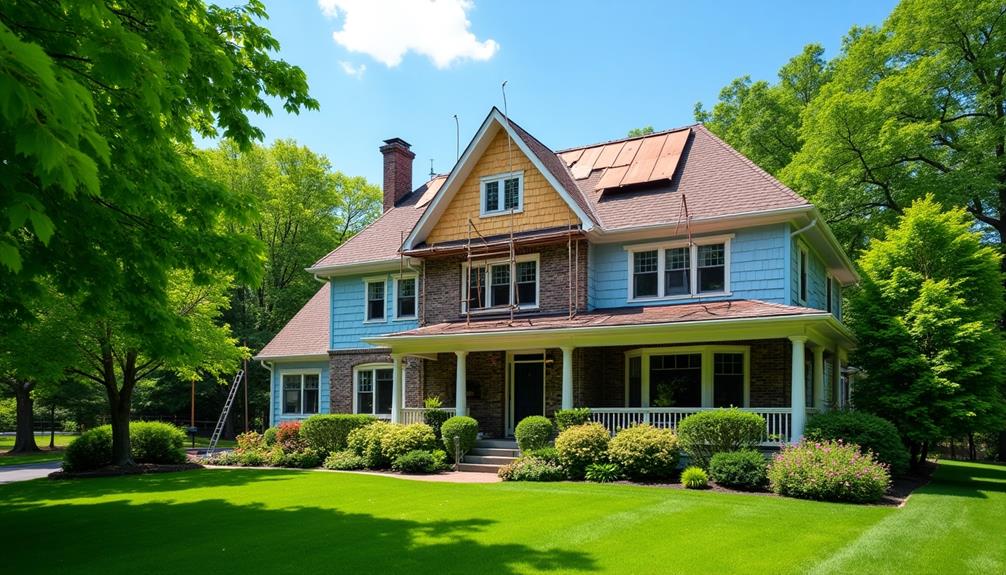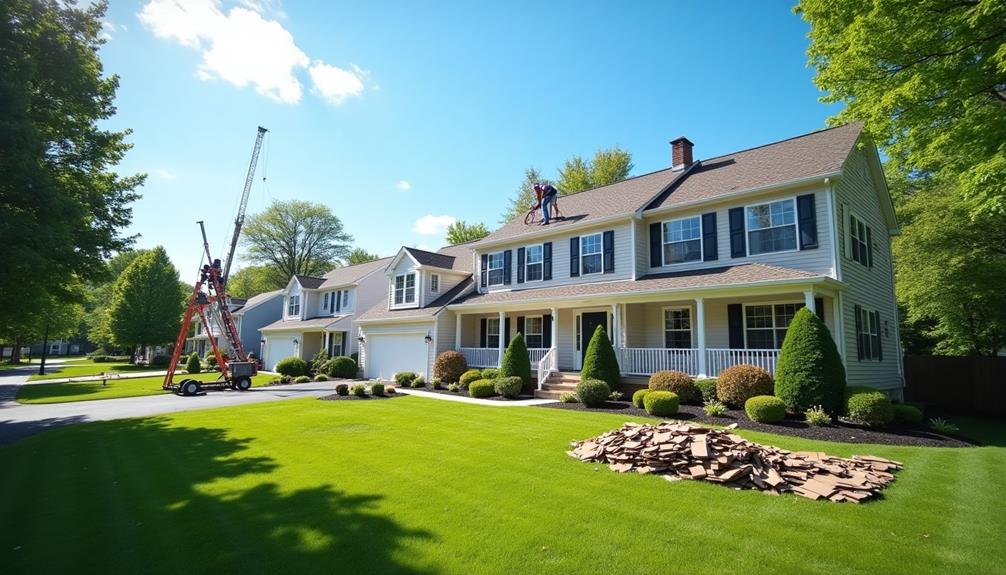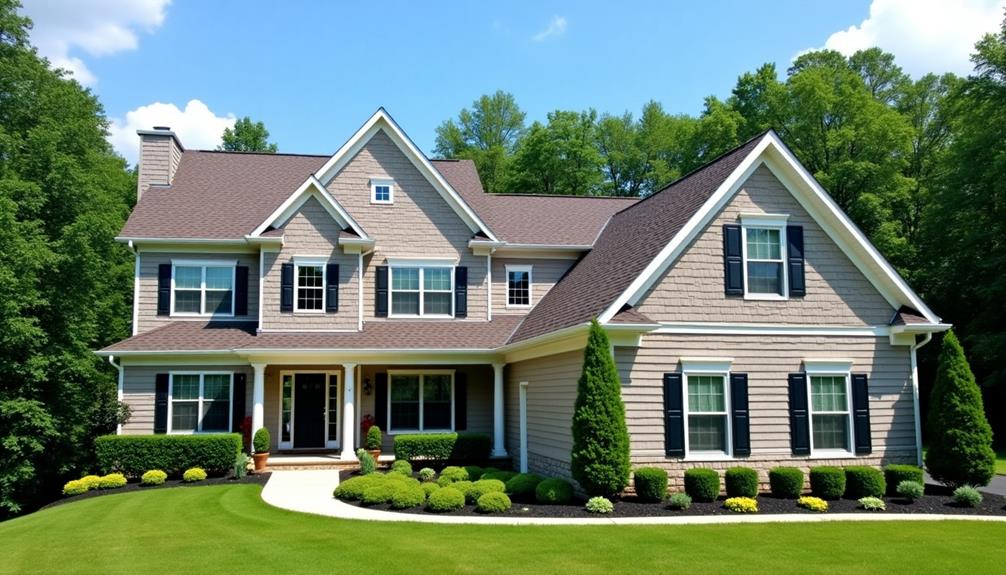If you're considering roof replacement in Demarest, NJ, it's crucial to act if you notice signs like water stains or curling shingles. Local weather conditions can exacerbate issues, making quality materials essential. Asphalt shingles are cost-effective, while metal roofs offer durability. Choosing a qualified contractor safeguards your investment, ensuring compliance with necessary permits and building codes. Timing also matters; spring and early fall are ideal for installation. A new roof boosts energy efficiency and property value, protecting your home. To make an informed decision, keep exploring your options and factors that influence your roofing project.
Signs You Need a Replacement
Recognizing the signs that you need a roof replacement can save you from costly repairs down the line. One of the first indicators is leak detection. If you notice water stains on your ceilings or walls, it's a clear sign that your roof isn't functioning properly.
Additionally, consider the shingle lifespan; most asphalt shingles last around 20 years. If your roof is approaching this age, it's wise to inspect it closely for damage.
Another crucial factor is energy efficiency. A deteriorating roof can lead to increased energy bills, as it may allow air to escape. Look for missing or curling shingles, which can significantly impact your home's insulation.
Lastly, the weather impact on your roof should never be underestimated. Extreme weather events, such as heavy rain or snow, can exacerbate existing problems. If your roof has suffered from multiple storms, it could be time for a replacement.
Choosing the Right Materials
After identifying the signs that indicate a roof replacement, the next important step is selecting the right materials for your new roof. Choosing the right materials isn't just about aesthetics; it also involves considering material durability, insulation properties, and cost efficiency.
Here's a quick comparison of common roofing materials:
| Material | Key Features |
|---|---|
| Asphalt Shingles | Cost-efficient, diverse aesthetic appeal, decent insulation properties |
| Metal Roofing | Durable, low environmental impact, excellent insulation |
| Slate | High durability, premium aesthetic appeal, long warranty options |
Evaluate the environmental impact of your choices, as some materials are more eco-friendly than others. Asphalt shingles offer great cost efficiency and are widely used, while metal roofs provide long-lasting durability and lower energy costs due to their insulation properties.
Don't forget to check warranty options as well; a good warranty can provide peace of mind and financial protection down the line. By carefully considering these factors, you'll not only enhance your home's appearance but also improve its overall performance and longevity. So, take your time and choose wisely!
Local Climate Considerations
When planning a roof replacement in Demarest, NJ, understanding the local climate is crucial to making an informed decision. The area's weather impacts your choice of roofing materials and installation techniques.
With its humid subtropical climate, Demarest experiences hot summers and cold winters, leading to significant seasonal considerations that can affect the longevity and performance of your roof.
During the summer, high humidity levels and intense storms can result in moisture accumulation, making it essential to choose materials that resist mold and mildew.
Opting for shingles with reflective coatings can also help reduce heat absorption, improving energy efficiency.
In winter, snow and ice can accumulate on your roof, necessitating durable materials that can withstand heavy loads and prevent ice damming.
Finding a Qualified Contractor
Choosing the right roofing materials tailored to Demarest's climate sets the stage for the next critical step: finding a qualified contractor. A skilled contractor can make all the difference in ensuring your roof replacement is executed flawlessly.
Start by verifying contractor qualifications. Look for licenses, insurance, and certifications that demonstrate their expertise and adherence to local building codes. This not only protects your investment but also ensures safety during the project.
Next, dive into contractor reviews. Online platforms and local forums can provide valuable insights into a contractor's reputation. Pay attention to feedback regarding timeliness, communication, and the quality of workmanship. A contractor with consistently positive reviews is more likely to deliver the results you expect.
Don't hesitate to ask for references from past clients. Speaking directly to previous customers can give you a clearer picture of what to expect.
Additionally, obtain multiple quotes to compare pricing and services offered, which helps you make an informed decision.
Roof Replacement Process Overview
Understanding the roof replacement process is crucial for making informed decisions.
You'll begin with an initial inspection to assess the current condition of your roof, followed by the installation steps that ensure a durable result.
Initial Inspection Steps
Before diving into the roof replacement process, it's crucial to conduct a thorough initial inspection. This step sets the foundation for a successful project, ensuring you understand the current state of your roof and what materials you'll need.
Start by using an inspection checklist that covers key areas such as shingles, flashing, gutters, and the underlayment. Look for signs of wear and tear, like missing or damaged shingles, rusted flashing, and clogged gutters.
Next, assess the roofing structure itself. Check for sagging, which could indicate underlying issues.
It's also essential to evaluate the attic for leaks or moisture, as these can compromise the roof's integrity. Document any findings, as this will inform your choice of roof materials and help you communicate effectively with contractors.
Installation and Cleanup Process
Once you've completed the initial inspection, the next phase involves the installation and cleanup process, which is essential for ensuring your new roof's longevity and performance.
During installation, skilled professionals employ precise installation techniques tailored to your specific roofing material and structure. They'll start by removing the old roofing, followed by necessary repairs to the underlying deck, ensuring a solid foundation for your new roof.
After laying the new roofing material, attention to detail is crucial. This includes proper sealing and flashing to prevent leaks and enhance durability. It's vital to choose a contractor who prioritizes these aspects, as improper installation can lead to costly issues down the line.
Equally important is the cleanup process. Adhering to cleanup best practices means removing debris and ensuring no nails or sharp objects remain on your property.
A thorough cleanup not only protects your landscape but also enhances safety for your family and pets. By understanding and prioritizing these steps, you can ensure that your roof replacement project is executed flawlessly, providing you with peace of mind and a sturdy roof for years to come.
Cost Factors to Consider
When planning a roof replacement in Demarest, NJ, several cost factors come into play that can significantly impact your budget.
First, material estimates will be one of your primary considerations. The type of roofing material—whether asphalt shingles, metal, or tile—affects both the initial cost and long-term durability. Higher-quality materials may require a larger upfront investment but can save you money on repairs in the future.
Next, consider labor costs. Skilled labor can vary based on local rates and the complexity of your roof's design. A steep or intricate roof may demand more expertise, driving up labor expenses.
Additionally, the size of your roof plays a crucial role; larger roofs naturally require more materials and labor.
Don't forget about potential hidden costs, such as the need for roof decking repairs or structural reinforcements. These can add to your overall budget if not accounted for in your initial material estimates.
Effective budget planning means considering all these factors upfront. By understanding the costs associated with your roof replacement, you can make informed decisions that align with your financial goals while ensuring quality and longevity.
Permits and Regulations in NJ
Before you start your roof replacement project in Demarest, NJ, it's crucial to understand the local permit requirements and building codes.
These regulations ensure your new roof meets safety standards and can affect your project's timeline and cost.
Familiarizing yourself with the inspection process will help you navigate potential hurdles and ensure a smooth installation.
Local Permit Requirements
Navigating the local permit requirements for roof replacement in Demarest, NJ, is crucial for ensuring compliance with state regulations and avoiding potential fines. Before you start your project, it's essential to understand the local zoning laws and the necessary permit applications. Failing to comply can lead to delays and additional expenses.
Here's a quick overview of key permit requirements you should consider:
| Requirement | Details | Notes |
|---|---|---|
| Local Zoning Approval | Check if your area has specific zoning restrictions. | Always confirm with local authorities. |
| Permit Application | Submit a detailed application with project plans. | Include all necessary documentation. |
| Inspection Fees | Budget for any required inspections. | Fees may vary based on project scope. |
| Timeframe for Approval | Allow time for local reviews and approvals. | Plan ahead to avoid project delays. |
Building Codes Overview
Understanding the building codes and regulations for roof replacement in New Jersey is essential for homeowners and contractors alike. These codes ensure that your roofing project adheres to safety standards, protecting both your investment and your family. In Demarest, specific local building codes dictate materials, installation processes, and structural integrity requirements.
Before you start any roofing work, you'll need to secure the appropriate permits. These permits not only verify that your project meets safety standards but also help avoid potential fines and legal issues down the line.
Familiarizing yourself with the New Jersey Uniform Construction Code can be invaluable, as it outlines the minimum safety standards for construction, including roof replacements.
Additionally, hiring a licensed contractor who understands these building codes can streamline the process. They'll ensure all work is compliant, minimizing the risk of costly corrections later.
Following these regulations is crucial, as non-compliance can lead to unsafe structures and decreased property value. So, make sure you're well-informed about your local building codes before embarking on your roof replacement project. Compliance isn't just about legality; it's about ensuring your home's safety and longevity.
Inspection Process Explained
Once you've secured the necessary permits for your roof replacement, the inspection process kicks in to ensure compliance with local regulations. This step is crucial for guaranteeing that your project meets safety standards and uses appropriate roof materials.
During the inspection, an official will examine your work against an inspection checklist, which includes criteria like structural integrity, proper installation techniques, and compliance with building codes.
They'll evaluate the roof materials you've chosen, ensuring they're suitable for your climate and meet the required standards.
It's essential to have all documentation ready, including your permit and any manufacturer specifications for your roofing materials. The inspector will also check for proper ventilation, drainage, and flashing installation—all vital for a long-lasting roof.
If any issues arise, they'll provide you with a detailed report highlighting necessary corrections. Addressing these promptly can prevent costly re-inspections and delays.
Remember, passing the inspection is a critical step in finalizing your roof replacement, ensuring not just compliance, but also the durability and safety of your new roof.
Stay proactive and informed; it'll make the process smoother and more successful.
Timing Your Roof Replacement
When it comes to timing your roof replacement, choosing the right season can make all the difference. Seasonal considerations play a crucial role in determining both the success of the project and your overall satisfaction.
Ideally, spring and early fall are the best times for roof replacement in Demarest, NJ. During these periods, the weather is typically mild, reducing the risk of weather-related delays and ensuring optimal conditions for materials to adhere properly.
If you start your project too late in the fall, you might face challenges with colder temperatures and potential snowfall, which can extend project timelines and impact the quality of the installation. Conversely, starting too early in the spring might mean dealing with unpredictable weather.
Planning ahead is key. Assess your roof's condition and schedule inspections before the peak seasons. This proactive approach allows you to secure contractors and materials when they're readily available.
Ultimately, aligning your roof replacement with favorable seasonal conditions not only enhances the installation process but also ensures your investment stands the test of time. So, take these factors into account to make informed decisions about your roof replacement project.
Benefits of Roof Replacement
Replacing your roof offers numerous advantages that extend beyond mere aesthetics. One significant benefit is improved energy efficiency. A new roof can better insulate your home, reducing energy costs and keeping your indoor environment comfortable year-round. This change not only lowers your utility bills but also enhances your home's overall aesthetic appeal, making it more attractive to potential buyers.
Additionally, a new roof significantly increases property value. When prospective buyers see a modern, well-installed roof, they're often willing to pay a premium, knowing they won't face immediate repairs.
Enhanced safety is another crucial factor; newer roofing materials are designed to withstand severe weather, protecting you and your loved ones.
You'll also experience notable noise reduction, creating a more serene living space. Beyond that, many insurance companies offer benefits for homes with newer roofs, potentially lowering your premiums.
Moreover, a new roof can positively impact the environment by using sustainable materials and improving energy efficiency.
Lastly, you'll have access to various warranty options, ensuring your investment is protected against future issues.
Maintaining Your New Roof
Maintaining your new roof is crucial to its longevity and performance.
Regular inspections help identify potential issues before they escalate, while proper cleaning techniques ensure that debris doesn't compromise its integrity.
Regular Inspections Importance
Regular inspections play a crucial role in extending the lifespan of your new roof. By identifying potential issues early, you can save yourself from costly repairs down the line. Regular inspections are an essential part of preventative maintenance, ensuring that your roof remains in optimal condition.
Here's a quick guide to help you understand inspection frequency and its benefits:
| Inspection Frequency | Benefits | Recommended Actions |
|---|---|---|
| Every 6 months | Early problem detection | Visual inspection, minor repairs |
| After severe weather | Assess storm damage | Comprehensive evaluation |
| Annually | Structural integrity review | Professional inspection |
| Before significant seasons | Prepare for weather extremes | Clean gutters, check seals |
Proper Cleaning Techniques
Keeping your new roof in top shape goes beyond just regular inspections; proper cleaning techniques are equally important. To maintain your roof's integrity and longevity, you should regularly remove roof debris such as leaves, branches, and dirt. This debris can trap moisture, leading to mold growth and potential damage.
When it comes to cleaning, choose the right cleaning products. Avoid harsh chemicals that can damage roofing materials. Instead, opt for biodegradable solutions specifically designed for roofs. These products effectively remove stains and contaminants without compromising the surface.
Use a soft-bristle broom or a roof rake to gently dislodge debris. If you encounter stubborn stains or algae, consider using a mixture of water and mild detergent. Always follow up with a thorough rinse using a garden hose, ensuring you don't leave any residue behind.
For safety, never attempt to clean your roof during wet or windy conditions. If your roof is steep or high, hiring a professional may be wise.

